Cash is king? The issues facing the OSV market

My latest round of advisory services to private equity and fund managers looking at investment opportunities in the OSV sector suggests that the headwinds facing the sector have become gale force in nature. Not just a couple of months ago, debate was around the green shoot opportunities that were emerging for vessel owners and operators and actions taken to improve liquidity. This debate is now focused on the ‘gale force wind’ that is making sea conditions not just choppy, but unsafe. Here I am talking of the principle of cash in hand and how best to manage it.
What has happened in the market, particularly within Southeast Asia, that underpins this change? The mega trends in the region are:
- Utilisation rates are down – we are seeing that rates are down to 50% in the AHTS and PSV sector, with some companies reporting utilisation down to as low as 23%.
- Charter day rates are down, the average being 40% down on rates achieved in 2014.
- The definition of ‘old’ vessel has changed from that being 20 years plus to now being only 15 years.
- Oversupply of vessels, with 476 units on order of which 200 are speculative.
- 11% of the total fleet has been laid up.
- Smaller vessels (below 80 bollard pull in the AHTS segment and below 3,200 dwt) are mostly being impacted.
- Rig ratios are down, with the global OSV fleet growing in the period 2015/16 by 18%, increasing the vessel to rig ration by approximately 35%.
- Rig usage, the primary driver in the sector, is down 20% globally and 38% down in Southeast Asia.
- Offshore projects E&P has been trimmed such that there has been a 15% reduction in offshore costs.
- Prices for secondhand vessels have fallen 40%.
The initial response by some, as I have reported before, was that the OSV market was really immune from the fallout and that it would be business as usual. More astute companies looked at opportunistic green shoots, such as offshore windfarm support as well as to other markets. Of particular interest was the Middle East (MENA) markets.
A quick profile of the MENA market showed that:
- Rig decline was the lowest in the global market.
- NOCs in the region chasing and maintaining production output.
- High level of tender activity with more than 75 vessels being sought by Saudi Aramco, Qatar Petroleum and Abu Dhabi NOC.
- Tender activity showed 77 different vessels required, including 29 AHTS.
- Utilisation rates in excess of 60%, making the spot market very attractive.
- 30% of the market controlled by five operators making it attractive entry.
The movement to this market as well as into green shoots such as windfarm has only had the impact of ‘sharing’ the oversupply / overcapacity around. This is hardly surprising when one considers, for example, that up to 25 vessel operators have tendered for work in the first quarter of 2016 in the MENA region. As of February 2016, the market is starting to look like Southeast Asia, with:
- Charter rates have fallen by 50% and in some cases to breakeven point or just below, some as low as $8,000 per day.
- 100 vessels now in lay up in the region.
- Utilisation rates now down to 50%.
- Oil companies now renegotiating existing contract rate with an expectation of a 20% reduction in those rates.
Other reactions in the sector, suggesting the depth to which the OSV market has sunk, is the emergence of what I call nationalistic tendencies. For example, Malaysia and Indonesia, two growth markets are enforcing and introducing strict cabotage regulations. The MENA region has embarked on the same process, making it very difficult for international operator prospects.
With this, there has been a review of asset values, particularly with regard to debt levels. A number of companies have reviewed their valuations as they have tried to restructure debt and payment terms. This has been a review of the fleet, particularly with regards to age and size, and with new vessels sales prices offering discounts of up to 30%, we have seen value wiped off the balance sheet.
With falling markets and prices of send hand vessels, Companies can no longer rely on asset sales to boost cash reserves. They will have to resort to other activities such as cutting operating expense, particularly by looking at systems and supply chains. Another option is to lock into longer contract terms at lower margins to generate cash i.e. the old fashioned approach of sacrificing margin for revenue that is bankable.
With the current gale and storm conditions expected to last until 2018, adherence to the principle of ‘Cash is King’ will pervade the OSV sector. This focus will dominate boardroom discussion for the next five years, and with low utilisation and charter rates in all markets, we can expect to see an increase in distressed asset sales.

We have been here before… post 1987. This looks to me like a very similar situation. Opportunities outside the oil patch are few and far between, and cannot do more than provide some utilisation at very thin rates.